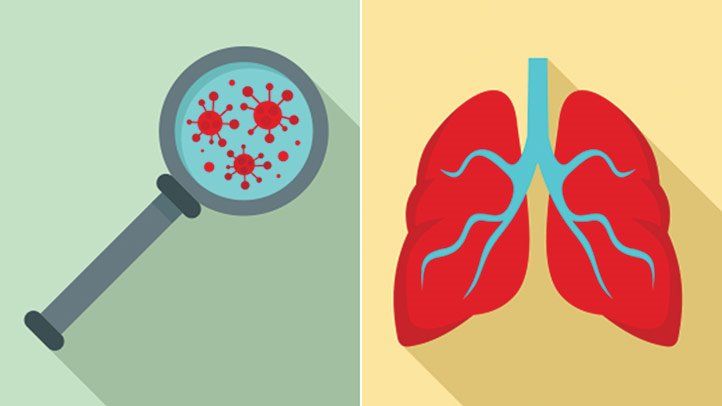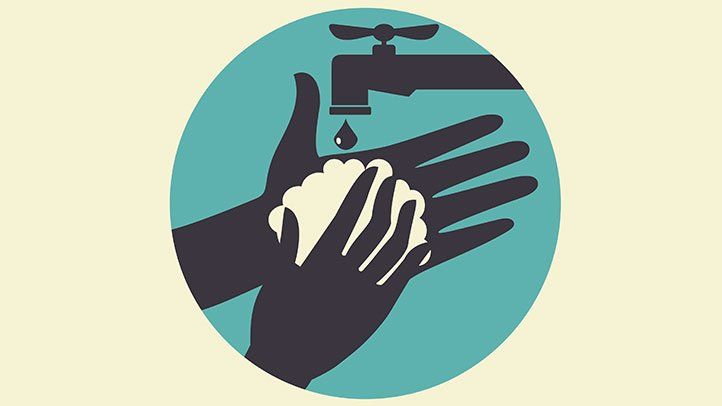Pneumonia is a lower respiratory lung infection that causes inflammation in one or both lungs.
Air sacs in your lungs called alveoli can then fill up with fluid or pus, causing flu-like symptoms that can persist for weeks or cause rapid deterioration of breathing leading to hospitalization. Pneumonia doesn't respond to over-the-counter cold and sinus medicines.
Pneumonia comes in different forms and is caused primarily by bacteria or viruses, which are contagious, and less commonly by fungi or parasites.
The type of germ contributes to how serious the illness can become and how it’s treated. The severity of an infection depends on many factors, including your age and overall health, as well as where you may have acquired the illness.
Causes and Risk Factors of Pneumonia
How do you get pneumonia? The majority of the germs that cause infection are spread from person to person through droplets, from coughing or sneezing.
- Asthma
- Cystic fibrosis
- Chronic obstructive pulmonary disease (COPD)
- A weakened immune system due to human immunodeficiency virus (HIV) or cancer
People who smoke are at higher risk for pneumonia, as are people on immunosuppressive medications, and people who are frequently in close, crowded spaces with others, such as college students and military personnel.
RELATED: 10 Pneumonia-Related Terms You Need to Know
What Types of Pneumonia Are There?
Your doctors will try to classify your type of pneumonia to help guide your treatment.
Community-Acquired Pneumonia (CAP)
You can also develop CAP after you get a viral infection, such as a cold or the flu or the SARS-CoV-2 virus, which causes COVID-19.
RELATED: What You Need to Know About the COVID-19 Pandemic
CAP ranges from mild to serious and, if left untreated, can lead to respiratory failure or death.
Various types of bacteria can be responsible for the illness. In most cases, the bacteria will enter the lung during inhalation, then travel into the bloodstream, potentially causing damage to other organs and systems in the body.
- Having an underlying lung disease, like asthma or COPD
- Having a systemic disease, such as diabetes
- Having a weakened immune system
- Abusing alcohol
- Smoking
Depending on how sick you are and whether you have any other health conditions, your doctor may treat you for a presumptive bacterial pneumonia with antibiotics either at home or in the hospital.
Antibiotics are ineffective against viral pneumonia. Your doctor will most likely treat the symptoms — fever, cough, and dehydration.
You or your child may need to be hospitalized if your viral pneumonia symptoms become severe.
Hospital-Acquired Pneumonia
Hospital-acquired pneumonia usually needs to be treated in the hospital with intravenous antibiotics.
Aspiration Pneumonia
This can develop after a person inhales food, drink, vomit, or saliva into their lungs. Once your lungs have been irritated by breathing in food or stomach contents, a bacterial infection can develop.
A strong gag reflex or cough will usually prevent aspiration pneumonia, but you may be at risk if you have a hard time swallowing or have a decreased level of alertness.
Aspiration pneumonia causes inflammation without bacterial infection. These pneumonias can sometimes be difficult to treat, especially because the patients are often sicker to begin with.
Some conditions that may put you at risk for aspiration pneumonia include:
- Loss of alertness due to medicines, illness, or surgery (getting anesthesia)
- Overuse of alcohol
- Old age
- Poor gag reflex due to brain injury or stroke
- Coma
Symptoms of aspiration pneumonia include cough, increased sputum, fever, confusion, and shortness of breath.
You can prevent complications by not eating or drinking before surgery, working with a therapist to learn how to swallow without aspirating, and avoiding heavy use of alcohol.
Opportunistic Infection
Finally, Pneumocystis pneumonia is a fungal pneumonia that is extremely rare in healthy people, according to the CDC, but develops in people with a weakened immune system; it’s often referred to as an opportunistic infection.
How Is Pneumonia Diagnosed?
“It’s a tough disease to diagnose,” says Marie Budev, DO, a pulmonologist and the medical director of the lung transplant program at the Cleveland Clinic in Ohio. “Age makes a big difference, as well as a person’s immune status … and, of course, the symptoms themselves.” Pneumonia symptoms often mimic those of the common cold and the flu, as well as acute bronchitis, an inflammation of the lining of your bronchial tubes (that carry air to and from your lungs).


Bronchitis vs. Pneumonia: Why They’re Related and How They’re Different
A pneumonia diagnosis is based on your medical history, a physical exam, and certain test results. Your doctor determines which type of pneumonia you have based on how you became infected, what your X-ray or lung exam reveals, and which kind of germ is responsible for your infection.
During a physical exam, your doctor will check your vital signs and listen to your lungs with a stethoscope. “Decreased breath sounds is an indication of a lot of inflammation,” says Michelle Barron, MD, a professor in the division of infectious diseases at University of Colorado School of Medicine in Aurora.
If your doctor suspects pneumonia, they may order further diagnostic tests, such as a chest X-ray to help determine the extent of the infection. Blood tests and an analysis of the patient’s sputum can pinpoint what’s causing the pneumonia. Pulse oximetry measures the oxygen level in your blood (which may be low if pneumonia is affecting your lungs).
Prognosis
Duration of Pneumonia
Recovery depends on what type of pneumonia you have and how severe it is, and the underlying condition of your lungs. Per the NHLBI, most people with bacterial pneumonia treated with antibiotics begin to improve and have fewer symptoms after one to three days. It's important, though, to continue taking the full course of antibiotics, even if you're feeling better. Otherwise, the pneumonia could return.
Prevention of Pneumonia
There’s no sure way to prevent pneumonia, but there are measures you can take, including pneumonia vaccines for some forms of the infection, and following sensible hygiene rules, to reduce your risk of being infected.
Practice good hygiene. Simple precautions, such as washing your hands frequently, covering your nose and mouth with a tissue when you cough or sneeze, and disposing of used tissues cut down exposure and spread of germs.


Why Proper Hand-Washing Is Essential During Cold and Flu Season
Don’t smoke. “Smokers are at a much greater risk of getting pneumonia because the protective mechanisms that your lungs set up to escalate debris out of your lungs are just paralyzed by tobacco,” says Jason Turowski, MD, a pulmonologist and associate director of the adult cystic fibrosis program at the Cleveland Clinic in Ohio.
Get vaccinated. Pneumococcal vaccines protect against one of the most common causes of bacterial pneumonia. The flu shot can help avoid influenza-related pneumonia and COVID-19 vaccines can lower your risk for pneumonia related to the coronavirus. Getting vaccinations “is the most important thing you can do,” Dr. Turowski says.
Complications of Pneumonia
Complications are more common in children, seniors, and people who are already challenged with other serious diseases, according to the NHLBI. Possible complications include the following:
- Respiratory failure is when a patient needs a breathing machine or ventilator to stay alive. A more severe form of respiratory failure is acute respiratory distress syndrome (ARDS); this has been associated with COVID-19.
- Sepsis is a condition in which bacteria from the lungs gets into your blood, causing uncontrolled inflammation in the body in response to infection; sepsis can lead to organ failure.
- Lung abscesses are areas of pus that form inside or around the lung. Sometimes antibiotics can take care of them, but surgery or an interventional radiologic procedure may be required to drain them.
- Kidney, liver, and heart damage can result when these organs don’t get enough oxygen or if your immune system responds negatively to the infection.
Related Conditions and Causes of Pneumonia
Resources We Love
Favorite Orgs for Essential Pneumonia Info
American Lung Association (ALA)
The ALA offers a thorough review of pneumonia, explaining exactly what it is, the symptoms, treatment options, and tips on prevention. The site also presents questions to ask your doctors to determine your risk and vaccines to consider.
American Thoracic Society
This nonprofit focuses on improving care for pulmonary (lung-related) diseases, critical illnesses, and sleep-related breathing disorders. As part of its patient education information series, they provide an extensive summary of pneumonia, covering causes, diagnosis, treatment, and concerns.
Centers for Disease Control and Prevention (CDC)
The CDC not only delivers the essential facts on causes, management, and prevention, the federal agency also connects to studies on the spread of the illness and methods to reduce its prevalence. The CDC stresses that smoking is a prominent risk factor for lung infection and offers resources and support to quit smoking, including advice from former smokers.
Healthy Children
Children under age 2 and people over 65 are two groups that are most likely to develop pneumonia. This organization, created by the American College of Pediatrics, covers the essentials that parents need to know when it comes to their kids and pneumonia. Recommendations on vaccinations are detailed.
National Heart, Lung, and Blood Institute (NHLBI)
This site addresses all major pneumonia concerns, including risk factors, screening and protection, symptoms and complications, diagnosis, and treatment. The NHLBI also explains how to live with the infection, how to participate in clinical trials for new medication, and methods to manage the illness.
Stop Pneumonia
This organization raises awareness about pneumonia’s deadly impact on children around the world. It focuses on promoting interventions to protect against, prevent, and treat the illness. The site reviews important vaccines and practices that can help ward off the disease for all young people.
Favorite Orgs That Can Help Fight Pneumonia
Senior Living
Those over age 65 have a higher risk of getting pneumonia than younger adults. They may be especially susceptible to community-acquired pneumonia, spread among large populations of elderly people in settings such as assisted living facilities. This organization, devoted to finding the best products and services for seniors, publishes advice on how older adults should handle prevention and care.
United Against the Flu
Influenza is a common cause of pneumonia. Several national healthcare organizations and the CDC are collaborating in an effort called United Against the Flu to stress the importance of getting immunized. The group’s website supplies resources and details on the vaccination.
Editorial Sources and Fact-Checking
- Pneumonia: Health Library. Johns Hopkins Medicine.
- Pneumonia. KidsHealth. August 2014.
- Pneumonia Symptoms and Diagnosis. American Lung Association. July 30, 2021.
- Pneumonia in Children — Community Acquired. MedlinePlus. October 25, 2020.
- Tramper-Stranders G. Childhood Community-Acquired Pneumonia: A Review of Etiology and Antimicrobial Treatment Studies. Pediatric Respiratory Reviews. July 14, 2017.
- Pneumonia: Symptoms and Causes. Mayo Clinic. June 13, 2020.
- Pneumonia. National Heart, Lung, and Blood Institute.
- Community-Acquired Pneumonia in Adults. MedlinePlus. August 3, 2020.
- What's the Difference Between Walking Pneumonia and Regular Pneumonia? Cleveland Clinic Health Essentials. February 19, 2019.
- Fast Facts You Need to Know About Pneumococcal Disease. Centers for Disease Control and Prevention. August 6, 2021.
- Community-Acquired Pneumonia in Adults. Cedars-Sinai Health Library.
- Pneumonia Can Be Prevented — Vaccines Can Help. Centers for Disease Control and Prevention. October 14, 2021.
- Pneumococcal Vaccine Timing for Adults. Centers for Disease Control and Prevention. November 6, 2020.
- Respiratory Syncytial Virus Infection (RSV). Centers for Disease Control and Prevention. December 18, 2020.
- What Causes Pneumonia. American Lung Association. October 23, 2020.
- Hospital-Acquired Pneumonia. MedlinePlus. July 23, 2019.
- Aspiration Pneumonia. MedlinePlus. July 23, 2019.
- Pneumocystis Pneumonia. Centers for Disease Prevention and Control. October 13, 2021.
- Pneumonia: Diagnosis and Treatment. Mayo Clinic. June 13, 2020.
- Learn About Pneumonia. American Lung Association. October 23, 2020.
- Pneumonia. Harvard Health Publishing. December 10, 2018.
- Pneumonia Treatment and Recovery. American Lung Association. August 16, 2021.
- Pneumonia. Cleveland Clinic. June 15, 2020.
- COVID-19 and Lung Damage. Johns Hopkins Medicine. April 12, 2021.
- Mycoplasma Pneumoniae Infection: Antibiotic Treatment and Resistance. Centers for Disease Control and Prevention. March 25, 2016.
- FastStats: Pneumonia. Centers for Disease Control and Prevention. September 13, 2021.
- Daily Updates of Totals by Week and State: Provisional Death Counts for Coronavirus Disease 2019 (COVID-19). Centers for Disease Control and Prevention. October 26, 2021.
- What Is the Connection Between Influenza and Pneumonia? American Lung Association. October 23, 2020.
- The Connection Between Pneumonia and Lung Disease. American Lung Association. November 12, 2018.
- Torres A, Cilloniz C, Niederman MS, et al. Pneumonia. Nature Reviews Disease Primers. April 8, 2021.













































